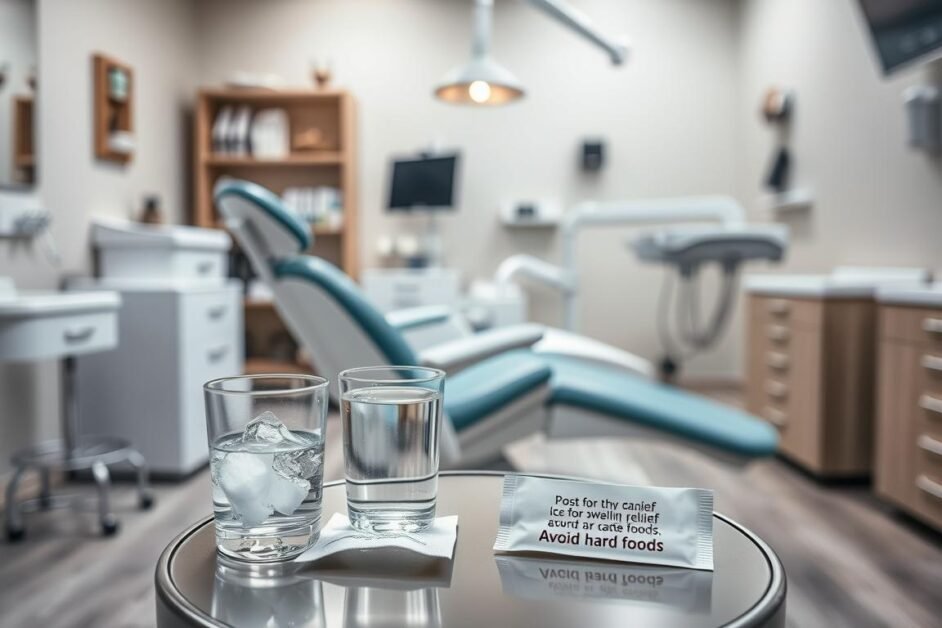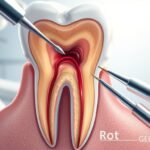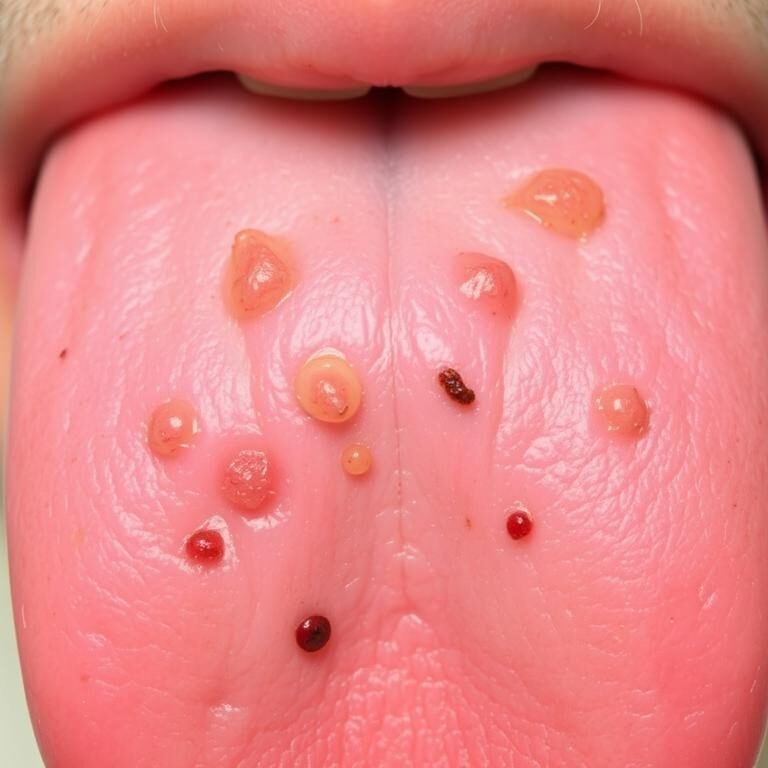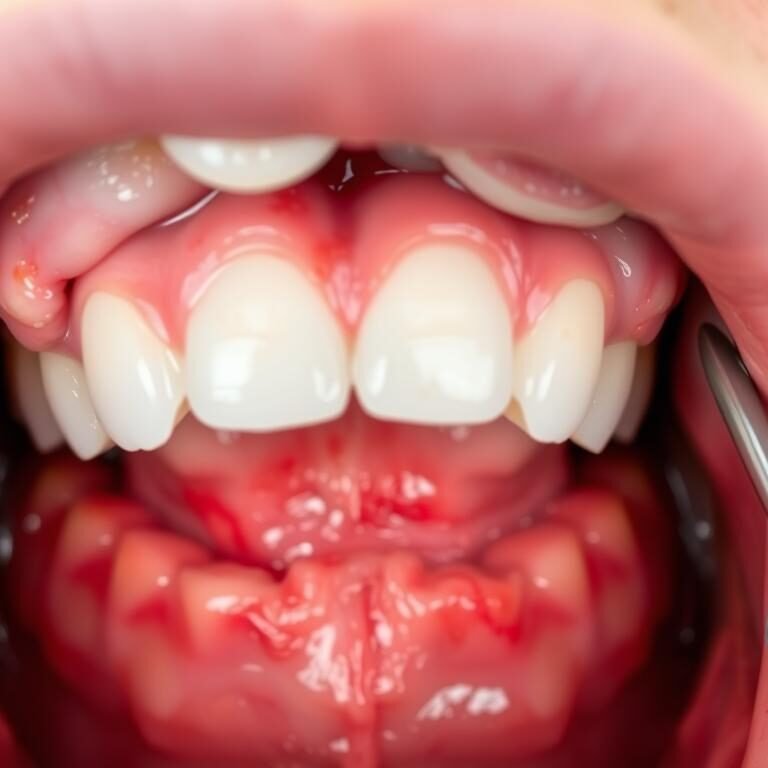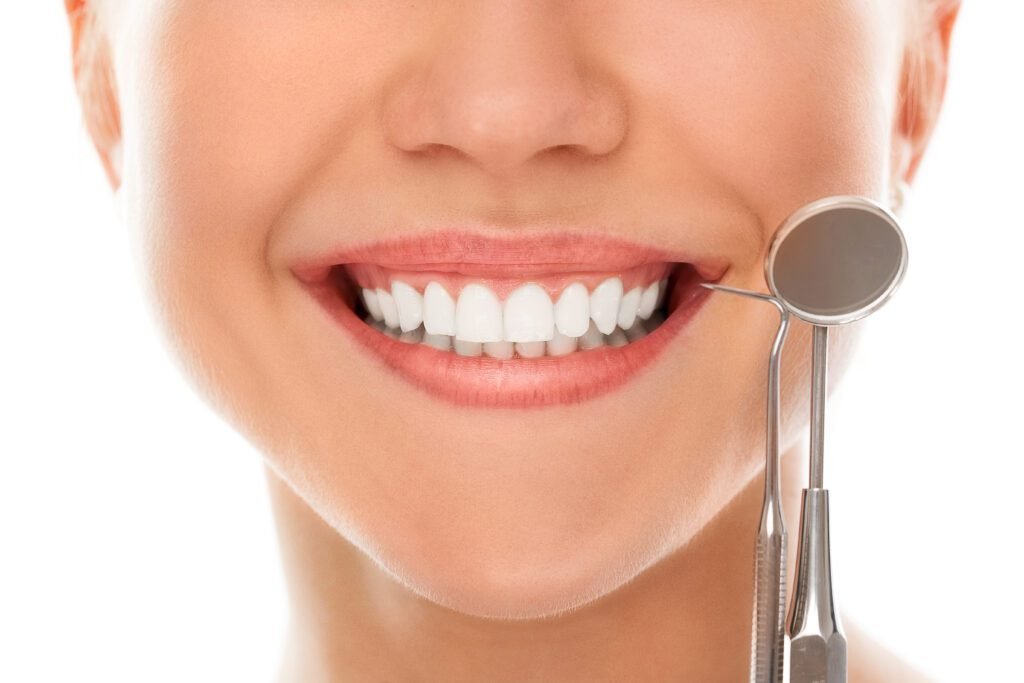Getting a root canal can seem scary. The thought of tooth pain and the procedure itself can make you feel anxious. But, once you leave the dentist, you start to feel better. It’s important to know how to take care of yourself after a root canal to heal well.
Proper care after a root canal is key to your health. It helps you heal faster. Eating soft foods and keeping your mouth clean are important steps. With these tips, you can get through the recovery period with ease.
Table of Contents
Understanding Root Canal Treatment
A root canal is a dental procedure to save a tooth from infection, decay, or damage. It’s simpler than you might think. The procedure removes the infected tissue in the tooth’s pulp, which stops pain and prevents more decay. After cleaning and disinfecting, the canal is sealed to protect against future problems.
Many people are surprised by the benefits of root canal treatment. It saves the natural tooth and avoids the need for extraction. A treated tooth can last as long as a natural one, with some lasting 10 to 20 years or more with proper care.
Signs you might need a root canal include a persistent toothache, sensitivity to temperature, and gum swelling. Most patients feel some discomfort after the procedure, but it usually goes away in a few days. Recognizing these symptoms early is key to a successful treatment. Understanding this process helps patients feel more confident about getting the treatment.
Proper anesthesia makes the procedure more comfortable. About 70% of patients prefer an endodontist for this reason. Following post-care instructions can also help with recovery—nearly 90% of patients have fewer complications when they do.

In summary, knowing about root canal treatment is crucial for good dental health. It helps ease pain and saves teeth, making it a key part of dental care.
What to Expect After a Root Canal
Many people wonder what happens after a root canal. The recovery is usually easier than after a tooth extraction. After the procedure, you’ll get local anesthetics. These can take hours to wear off.
Wait about 30-40 minutes before brushing your teeth again. This lets the temporary filling harden.
Once the anesthetic wears off, you can eat again. But, it’s best to avoid sticky foods and chewing directly on the treated tooth. Most people can go back to work the same day. Those in jobs where they meet the public might want to take the rest of the day off.
In the first few days, you might feel some discomfort or sensitivity. This is a common root canal side effect and usually goes away in a week. You can use over-the-counter pain relievers, as strong prescription drugs are rarely needed.
On average, it takes a week to feel fully comfortable again. Some might need to come back for more pain management or to check on healing. You’ll need a dental crown within 1-2 weeks to protect and restore your tooth.
Root canal success rates are high, with complications like reinfection happening in less than 5% of cases. When you follow aftercare instructions, about 90% of patients are happy with the results.
Root Canal After Care: Essential Steps
After a root canal, following root canal care tips is key for a smooth recovery. Every year, 15 million root canals are done in the U.S. Success rates are high, ranging from 85% to 97%. Taking the right steps after a root canal helps avoid pain and complications.
It’s important to wait until the numbness wears off before eating. This prevents biting your cheek or tongue. Keeping your mouth clean with warm saltwater rinses is also crucial. It helps in healing and reduces complications by 50%.
Stick to a soft diet to ease your recovery. Eating soft foods like yogurt and mashed potatoes helps. It reduces pain by nearly 30% and aids in healing.
After a root canal, you might feel some pain for 3 to 7 days. About 75% of people find over-the-counter pain meds work well. If pain lasts longer, talk to your dentist for personalized post root canal recovery strategies.
Don’t skip follow-up appointments. They help prevent complications by 30% to 40%. For more tips on keeping your mouth healthy, check out this resource. Following these essential aftercare steps is crucial for your root canal’s success.
Managing Pain After a Root Canal
Feeling pain after a root canal is common and can be managed. Knowing how to handle root canal pain management is key. Most people feel mild to moderate soreness for a few days, which goes away with time.
There are many ways to ease pain after a root canal. You can use medications and make lifestyle changes.
Recommended Pain Relief Medications
For pain relief after a root canal, try over-the-counter medicines. Ibuprofen or acetaminophen can help with pain and swelling. Ibuprofen also helps reduce swelling, making you feel better.
If your pain doesn’t go away or gets worse, your dentist might give you stronger medicine.
When to Contact Your Dentist for Pain Management
Keep an eye on how you feel after your root canal. If pain lasts more than a few days or gets worse, call your dentist. Signs you should see your dentist include swelling, fever, or more pain.
Also, if you have bad breath or a bad taste, it could mean you need to see your dentist. For help with dental emergencies, check out this resource.
Dietary Adjustments Post Root Canal Care
After a root canal, changing your diet is key to a smooth recovery. These changes help reduce pain, protect temporary crowns, and aid healing. Knowing what to eat after root canal can make recovery easier and help with any lingering pain.
Foods to Eat After a Root Canal
In the first 2-3 days, eat soft foods that are easy to swallow. Here are some good options:
- Mashed potatoes
- Applesauce
- Bananas
- Ripe pears
- Well-cooked vegetables
- Blended soups
- Yogurt
- Smoothies
- Scrambled eggs
- Soft-cooked pasta
- Soft white bread
- Steamed buns
- Oatmeal
These foods are nutritious and gentle on your mouth. Wait 30 to 45 minutes after the procedure to eat. Also, keep your mouth clean by brushing gently and flossing carefully.
Foods to Avoid During Recovery
Some foods should be avoided to help healing and avoid pain. Here are the ones to skip:
- Hard foods such as nuts, seeds, and hard candies
- Chewy foods like tough meats and chewy candies
- Sticky items such as caramel
- Very spicy foods
- Extremely hot or cold beverages
Staying away from these foods helps avoid irritation and damage to temporary crowns. Most people can go back to normal eating a few days later. For more on what to eat, check out this resource.
Importance of Oral Hygiene After Root Canal
Keeping your mouth clean after a root canal is key to healing well. If you don’t take care of your teeth, you might get infections or take longer to heal. Dentists stress the need for brushing and flossing to help your mouth recover.
Brush your teeth gently at least twice a day. Use a soft-bristled toothbrush to avoid hurting your gums. Flossing once a day is also crucial to clean hard-to-reach areas. Adding an antiseptic mouthwash can help kill bacteria and keep your mouth fresh.
If your gums are sore, try rinsing with warm saltwater. It helps with healing and doesn’t irritate your gums.
Studies show that good oral hygiene can cut down on complications by up to 60%. A study found that 92% of patients with good oral care had fewer issues. Regular dental visits are also important. They let dentists check on your tooth’s health and fix problems early.
In short, taking care of your mouth after a root canal helps you heal faster and keeps your teeth healthy for longer. Following these tips can make your recovery smoother and prevent extra problems.
Using Cold Compresses for Swelling Relief
Swelling is common after a root canal. Using a cold compress is a top way to manage swelling. It works by narrowing blood vessels and numbing the area.
How to Apply a Cold Compress
To use a cold compress for swelling, follow these steps:
- Wrap ice cubes or a cold pack in a clean cloth to protect the skin.
- Gently place the cold compress on the outside of your cheek where the treatment occurred.
- Maintain the compress on the swollen area for 10–15 minutes at a time.
- Take breaks between applications, allowing for at least 20 minutes of rest without the ice.
Recommended Duration and Frequency
The cold compress duration after root canal is key. Use it several times a day, mainly in the first 1-2 days. Aim for six to eight applications, with 20-minute breaks in between. This helps manage swelling and makes recovery more comfortable.
For more on post-treatment care, including medication and relaxation, visit this guide.
Timeframe for Recovery from Root Canal
Knowing how long it takes to recover from a root canal is key. It usually takes about 1 to 2 weeks. This time can vary based on your health and the treatment’s complexity.
Right after the treatment, you might feel some pain. This pain is usually mild and can be managed with over-the-counter meds. In the first 24 to 48 hours, the pain starts to lessen. By day 3, you’ll likely feel much better and can start doing normal things again. By the end of the first week, any remaining pain should be very mild.
- About 50% of people might still feel some discomfort for a few days.
- Around 10% might experience more severe pain that lasts longer than a week.
- If you had multiple canals or a complex case, you might take a bit longer to recover.
- People with health issues might need 1.5 to 2 times longer to get better.
By two weeks after the treatment, you should be fully recovered. Your tooth should be back to normal. Following the dentist’s post-care instructions can help avoid complications and speed up your recovery.
| Recovery Milestone | Timeframe | Patient Experience |
|---|---|---|
| Initial Discomfort | 0-2 Days | Mild discomfort manageable with over-the-counter medication |
| Significant Pain Reduction | 3 Days | Most report a considerable decrease in pain |
| Minimal Pain Remaining | End of Week 1 | 90% of patients experience relief |
| Full Recovery | 2 Weeks | Functional restoration with ongoing care |
Keeping track of your healing is important. Regular check-ups with your dentist can help you stay on track. This way, you can catch any problems early and recover faster.
Rest and Recovery: A Critical Component
Getting enough rest after root canal treatment is key for healing. Many people feel some pain after the procedure. It’s important to avoid hard activities for the first 48 hours to help your body heal.
The first 24 hours are very important for rest. Sleeping well, aiming for 7-8 hours, can speed up healing by 30%. Eating a balanced diet also helps by reducing the chance of longer recovery times.
In the first week, you can slowly get back to your usual activities. But, it’s best to do gentle things and listen to your body. Eating soft foods for 48 hours helps avoid irritation and speeds up healing. About 90% of people fully recover in 2-3 weeks after their root canal.
| Recovery Tips | Description |
|---|---|
| Adequate Rest | Ensure enough sleep and relaxation to promote healing. |
| Soft Foods | Consume gentle foods to avoid irritation for the first 48 hours. |
| Hydration | Stay well-hydrated to aid in healing and comfort. |
| Pain Management | Utilize over-the-counter pain relievers as needed to control discomfort. |
| Follow-Up Appointments | Attend all scheduled dental check-ups for optimal recovery monitoring. |
| Stress Management | Engage in light activities such as yoga or leisurely walks to reduce stress. |
Follow-Up Appointments with Your Dentist
It’s very important to schedule a dentist follow-up after root canal treatment. This is to make sure the healing is going well. These check-ups are usually set six to twelve months after the treatment.
They help the dentist see how the treated tooth is doing. This way, they can spot any problems early. This shows how important dental appointments are.
These visits are quick and often don’t cost anything. Your dentist might take X-rays to check on the healing. They might also suggest more visits every six months for up to two years to keep an eye on the tooth.
- Evaluate healing progress
- Address any concerns or discomfort
- Determine if additional treatments, like a permanent crown, are necessary
Going to these follow-up appointments is key for your dental health. It helps avoid needing more treatments later on.
Signs of Complications After a Root Canal
After a root canal, it’s key to watch for any signs of trouble. Catching problems early can stop them from getting worse. Knowing the signs of issues post root canal helps a lot in getting better.
Symptoms of Jaw Infection After Root Canal
After a root canal, infection can cause several symptoms. These include:
- Persistent pain lasting more than 3 days
- Swelling around the treated area
- Fever alongside oral soreness
- Persistent bad breath that does not improve with hygiene measures
- Fatigue that may indicate spreading infection
About 15% of patients face ongoing pain, showing possible complications. Up to 10% might get an abscess within 7-10 days. If you see these jaw infection symptoms post root canal, you need urgent dental care.
When to Seek Immediate Care
It’s crucial to know when to contact dentist for quick recovery. Seek immediate dental care if you have:
- Severe pain that does not subside
- Prolonged swelling that persists beyond a week
- Fever associated with increased discomfort or swelling
These signs suggest complications after a root canal that need attention. Ignoring them can increase the risk of reinfection and more procedures. Regular dental visits are key to avoid these risks. For more on dental health, check out this resource.
Avoiding Harmful Habits Post Treatment
After a root canal, it’s key to focus on healing and make lifestyle changes. Bad habits can slow down healing and cause problems. Smoking and drinking alcohol are big no-nos for recovery.
Can You Smoke After a Root Canal?
Smoking after a root canal is a big no. Tobacco effects on healing are serious. It can slow down blood flow and healing.
Bad blood flow raises the risk of infections and more. It’s best to avoid smoking and think about quitting for good.

The Risks of Alcohol Consumption
Drinking alcohol after a root canal is also a bad idea. The alcohol risks after root canal are real. It can mess with medication, cause swelling, and lead to complications.
Stick to the alcohol guidelines after treatment. Wait until your dentist says it’s okay to drink. This helps you heal better.
Tips for a Successful Root Canal Recovery
To recover well after a root canal, it’s key to follow good recovery strategies. Stick to your dentist’s advice on what to eat. Avoid hard, crunchy, and hot foods to keep the treated area safe and reduce pain. Opt for soft foods like frozen yogurt, mashed potatoes, and bananas to help your body heal.
Managing pain is a big part of getting better. You might feel some discomfort in the first few days, but it should get better over time. Taking over-the-counter pain meds like Advil can help a lot. Also, using cold compresses for 20 minutes every 20 minutes can help with swelling and pain, making your recovery smoother.
Keeping your mouth clean is also crucial. Use warm salt water rinses to help with healing and prevent infections. Don’t forget to keep your follow-up appointments. They help your dentist check on your progress and catch any problems early. For more tips on your recovery, check out this resource.
FAQ
What can I expect after a root canal?
After a root canal, you might feel some pain and swelling. This usually goes away in a few days. You might also feel sensitive when you bite down.
Can I eat after a root canal?
Yes, but wait until the numbness wears off first. Start with soft foods like yogurt and mashed potatoes to avoid discomfort.
How long after a root canal can I eat solid foods?
Wait a few hours after the procedure. Once numbness is gone, you can start with soft foods. Gradually add more solid foods.
Can I smoke after a root canal?
No, it’s not good to smoke after a root canal. It can slow healing and increase infection risk.
How long does it take to recover from a root canal?
Recovery takes about 1-2 weeks. It depends on your health and the procedure’s complexity. You’ll likely feel less pain over time.
What should I do to manage pain after a root canal?
Use over-the-counter pain meds like ibuprofen or acetaminophen. If pain lasts more than a few days or gets worse, see your dentist.
Are there any specific foods to avoid after a root canal?
Yes, avoid hard, crunchy, or very hot foods. They can irritate the area or damage temporary crowns. Also, skip spicy foods during recovery.
How important is oral hygiene after a root canal?
Keeping your mouth clean is key after a root canal. Brush gently and floss daily. This helps prevent infections and keeps your gums and teeth healthy.
What are the signs of needing a follow-up visit after a root canal?
Watch for persistent pain, big swelling, or fever. These signs mean you need to see your dentist right away.
How can I alleviate swelling after a root canal?
Use a cold compress on the outside of your face where the procedure was done. Do this for 20 minutes, then take a break.
Can I consume alcohol after a root canal?
It’s best to avoid alcohol right after the procedure. It can slow healing and increase the risk of problems.

